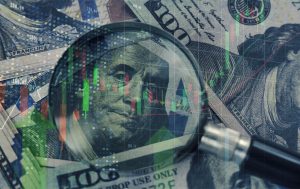Today’s forex markets saw significant movements as the U.S. dollar weakened and the Swiss franc gained strength following key central bank decisions. The U.S. dollar’s rally, which briefly benefited from positive economic data, faltered, while the Swiss franc rose after the Swiss National Bank (SNB) announced a 25 basis point interest rate cut. Here’s a deeper dive into what happened across the markets:
Key Highlights:
- Swiss Franc Strengthens: The SNB cut interest rates by 25 basis points, strengthening the franc against the dollar, with the USD/CHF falling 0.55% to 0.846. This move follows in line with recent rate cuts from the Federal Reserve and the European Central Bank (ECB). The SNB left the door open for further cuts as inflation continues to cool.
- U.S. Dollar Slips: The dollar index (DXY) fell 0.42%, hitting 100.52, marking its sixth drop in seven sessions. Earlier, the greenback had been buoyed by U.S. jobless claims data showing a fall to a four-month low of 218,000, below expectations. However, the rally was short-lived as markets continue to focus on the likelihood of further U.S. rate cuts. The Federal Reserve is now expected to deliver another cut of at least 25 basis points at its upcoming meeting in November.
- Euro and Pound Surge: The euro (EUR/USD) rose 0.41% to $1.1178, with traders eyeing a potential break of the August high at $1.1201. Meanwhile, the British pound (GBP/USD) climbed 0.71% to $1.3417, on course for its biggest daily percentage gain in a month. Both currencies benefited from the weakening dollar and recent central bank moves.
- Japanese Yen Firms Slightly: The yen (USD/JPY) gained 0.1% to 144.6 per dollar. This followed mixed signals from the Bank of Japan (BOJ), where policymakers remain divided on the pace of future rate hikes. Market speculation is rising around the timing of the next BOJ rate increase, as inflation in Tokyo slowed to 2.2% in September from 2.6% in August. This cooling inflation could give the BOJ more time to assess conditions before its next policy move.
Swiss Franc Boost from Rate Cut
The Swiss National Bank’s decision to cut rates by 25 basis points surprised some traders who had expected a larger cut in response to the Fed’s outsized rate reduction last week. However, the SNB’s move was largely driven by cooling inflation, bolstered by the strength of the Swiss franc, which has helped dampen inflationary pressures.
Analysts at Goldman Sachs expect the SNB to continue easing, with another 25 bps cut forecasted at the December meeting. This dovish outlook contrasts with previous expectations and will likely keep the franc supported against the dollar and other major currencies.
U.S. Dollar’s Fading Momentum
While the U.S. dollar briefly rallied on positive economic data, including a drop in jobless claims and strong corporate profit growth, its upward momentum quickly faded. The Federal Reserve’s recent focus on maintaining a healthy labor market, combined with its 50 bps rate cut last week, has driven market expectations that the Fed will continue to lower rates, with a 51.3% chance for another half-point cut at the next meeting.
The market’s response to this dovish tone has kept the dollar on the backfoot, with investors favoring risk assets and currencies like the euro and pound.
Impact on the Japanese Yen
The Japanese yen also saw some movement today, firming slightly against the dollar. Data showing a slowdown in inflation in Tokyo, particularly in energy prices, suggests that the BOJ may not rush into further rate hikes. While core-core inflation—which excludes fresh food and energy—remained steady at 1.6%, the BOJ will closely monitor service inflation, a key indicator of wage growth and consumer spending, before making its next policy move.
Investors are also closely watching the outcome of the Liberal Democratic Party leadership election in Japan. The election’s results could significantly influence yen movements, with a potential win by Shigeru Ishiba seen as JPY-supportive, while a victory for Sanae Takaichi could weaken the yen.
Looking Ahead
The global market focus now shifts to upcoming data releases and central bank meetings. With the Fed’s November meeting on the horizon, traders will be closely watching U.S. economic data, especially jobless claims and GDP growth figures. Meanwhile, the BOJ and ECB will likely continue their cautious approaches, while the Bank of England holds rates steady amid continued inflation concerns.
The path ahead for major currencies, including the U.S. dollar, euro, pound, and yen, will largely depend on how central banks navigate slowing growth and persistent inflation, especially as expectations for further rate cuts build across the globe.
Takeaway: The U.S. dollar’s weakness is being driven by dovish expectations from the Federal Reserve, while currencies like the Swiss franc, euro, and pound have benefited from central bank decisions and a shift away from the dollar. Investors should watch closely for further moves from the Fed, BOJ, and SNB, which will continue to shape market dynamics in the weeks to come.




